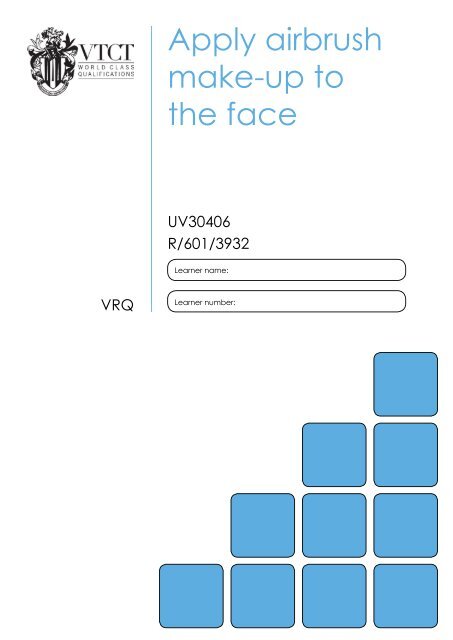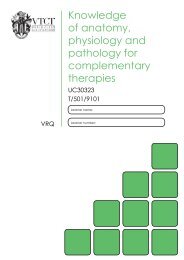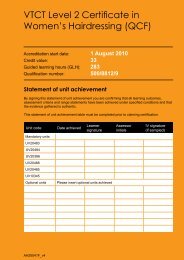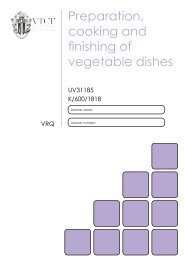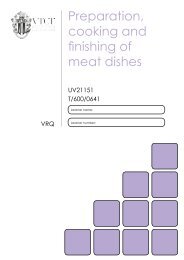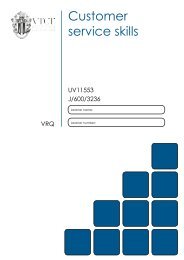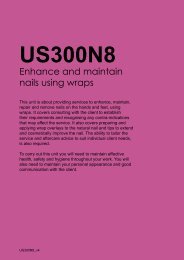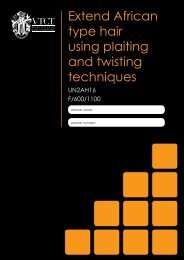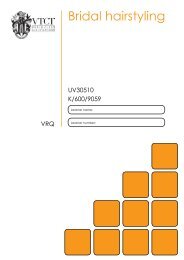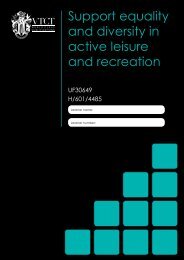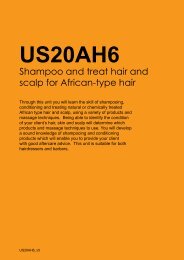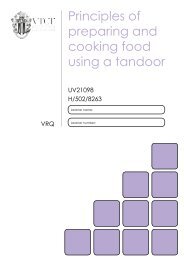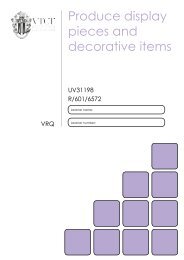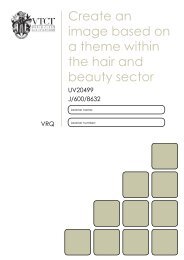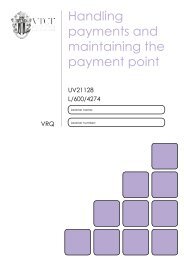Apply airbrush make-up to the face - VTCT
Apply airbrush make-up to the face - VTCT
Apply airbrush make-up to the face - VTCT
You also want an ePaper? Increase the reach of your titles
YUMPU automatically turns print PDFs into web optimized ePapers that Google loves.
VRQ<br />
<strong>Apply</strong> <strong>airbrush</strong><br />
<strong>make</strong>-<strong>up</strong> <strong>to</strong><br />
<strong>the</strong> <strong>face</strong><br />
UV30406<br />
R/601/3932<br />
Learner name:<br />
Learner number:
Statement of unit achievement<br />
<strong>VTCT</strong> is <strong>the</strong> specialist awarding body for <strong>the</strong> Hairdressing, Beauty Therapy,<br />
Complementary Therapy and Sport and Active Leisure sec<strong>to</strong>rs, with over 45<br />
years of experience.<br />
<strong>VTCT</strong> is an awarding body regulated by national organisations including<br />
Ofqual, SQA, DCELLS and CCEA.<br />
<strong>VTCT</strong> is a registered charity investing in education and skills but also giving <strong>to</strong><br />
good causes in <strong>the</strong> area of facial disfigurement.<br />
By signing this statement of unit achievement you are confirming that all learning outcomes, assessment<br />
criteria and range statements have been achieved under specified conditions and that <strong>the</strong> evidence<br />
ga<strong>the</strong>red is au<strong>the</strong>ntic.<br />
This statement of unit achievement table must be completed prior <strong>to</strong> claiming certification.<br />
Unit code Date achieved Learner signature<br />
Assessor tracking table<br />
Assessor name Assessor signature<br />
Assessor<br />
initials<br />
Assessors<br />
initials<br />
IV signature<br />
(if sampled)<br />
All assessors using this Record of Assessment book must complete this table. This is required for<br />
verification purposes.<br />
Assessor number<br />
(optional)
UV30406<br />
<strong>Apply</strong> <strong>airbrush</strong> <strong>make</strong>-<strong>up</strong> <strong>to</strong> <strong>the</strong><br />
<strong>face</strong><br />
This unit is about applying <strong>airbrush</strong> <strong>make</strong>-<strong>up</strong> <strong>to</strong> <strong>the</strong> <strong>face</strong><br />
and body. You will need <strong>to</strong> show that you can carry out a<br />
variety of <strong>airbrush</strong> <strong>make</strong>-<strong>up</strong> designs and techniques, and<br />
you will learn how <strong>to</strong> use a range of <strong>airbrush</strong> products.<br />
UV30406_v5
Level<br />
Credit value<br />
GLH<br />
3<br />
4<br />
27<br />
Observation(s)<br />
4<br />
External paper(s)<br />
1
<strong>Apply</strong> <strong>airbrush</strong> <strong>make</strong>-<strong>up</strong> <strong>to</strong> <strong>the</strong><br />
<strong>face</strong><br />
Learning outcomes Evidence requirements<br />
On completion of this unit you will:<br />
1. Be able <strong>to</strong> plan and prepare for <strong>airbrush</strong><br />
<strong>make</strong>-<strong>up</strong> application<br />
2. Be able <strong>to</strong> apply <strong>airbrush</strong> <strong>make</strong>-<strong>up</strong><br />
1. Environment<br />
Evidence for this unit must be ga<strong>the</strong>red in a<br />
real or realistic working environment.<br />
2. Simulation<br />
Simulation is not allowed in this unit.<br />
3. Observation outcomes<br />
Competent performance of ‘Observation’<br />
outcomes must be demonstrated <strong>to</strong> your<br />
assessor on at least four occasions.<br />
4. Range<br />
All ranges must be practically demonstrated<br />
or o<strong>the</strong>r forms of evidence produced <strong>to</strong><br />
show <strong>the</strong>y have been covered.<br />
5. Knowledge outcomes<br />
There must be evidence that you possess<br />
all <strong>the</strong> knowledge and understanding<br />
listed in <strong>the</strong> ‘Knowledge’ section of this<br />
unit. This evidence may include projects,<br />
assignments, case studies, reflective<br />
accounts, oral/written questioning and/or<br />
o<strong>the</strong>r forms of evidence.<br />
6. Tu<strong>to</strong>r/Assessor guidance<br />
You will be guided by your tu<strong>to</strong>r/assessor<br />
on how <strong>to</strong> achieve learning outcomes and<br />
ranges in this unit. All outcomes and ranges<br />
must be achieved.<br />
7. External paper<br />
Knowledge and understanding in this unit<br />
will be assessed by an external paper.<br />
The criteria that <strong>make</strong> <strong>up</strong> this paper are<br />
highlighted in white throughout this unit.<br />
There is one external paper that must be<br />
achieved.<br />
UV30406<br />
3
4<br />
Achieving observations<br />
and range<br />
Achieving observation outcomes<br />
Your assessor will observe your performance<br />
of practical tasks. The minimum number<br />
of observations required is indicated in <strong>the</strong><br />
evidence requirements section of this unit.<br />
Criteria may not always naturally occur during<br />
a practical observation. In such instances you<br />
will be asked questions <strong>to</strong> demonstrate your<br />
competence in this area. Your assessor will<br />
document <strong>the</strong> criteria that have been achieved<br />
through oral questioning.<br />
Your assessor will sign off an outcome when all<br />
criteria have been competently achieved in a<br />
single client service.<br />
Achieving range<br />
The range section indicates what must<br />
be covered. Ranges should be practically<br />
demonstrated as part of an observation. Where<br />
this is not possible o<strong>the</strong>r forms of evidence may<br />
be produced. All ranges must be covered.<br />
Your assessor will document <strong>the</strong> portfolio<br />
reference once a range has been competently<br />
achieved.<br />
UV30406<br />
Maximum service times<br />
The following maximum service times apply <strong>to</strong><br />
this unit:<br />
Full <strong>face</strong> straight <strong>airbrush</strong><br />
<strong>make</strong>-<strong>up</strong><br />
30 minutes
Outcome 1<br />
You can:<br />
a. Prepare yourself, client and work area for<br />
<strong>airbrush</strong> <strong>make</strong>-<strong>up</strong><br />
b. Use suitable consultation techniques <strong>to</strong><br />
identify treatment objectives<br />
c. Carry out skin analysis<br />
d. Provide clear recommendations <strong>to</strong> <strong>the</strong> client<br />
e. Select products, <strong>to</strong>ols and equipment <strong>to</strong><br />
suit client treatment needs, skin type and<br />
conditions<br />
*May be assessed through oral questioning.<br />
Observations<br />
Be able <strong>to</strong> plan and prepare for <strong>airbrush</strong> <strong>make</strong>-<strong>up</strong> application<br />
Observation 1 2 3 4<br />
Date achieved<br />
Criteria questioned orally<br />
Portfolio reference<br />
Assessor initials<br />
Learner signature<br />
UV30406 5
6<br />
Outcome 2<br />
Be able <strong>to</strong> apply <strong>airbrush</strong> <strong>make</strong>-<strong>up</strong><br />
You can:<br />
a. Communicate and behave in a professional<br />
manner<br />
b. Follow health and safety working practices<br />
c. Position yourself and <strong>the</strong> client correctly<br />
throughout <strong>the</strong> treatment<br />
d. Use products, <strong>to</strong>ols, equipment and<br />
techniques <strong>to</strong> meet <strong>the</strong> design plan and <strong>to</strong><br />
suit client treatment needs, skin types and<br />
conditions<br />
e. Complete <strong>the</strong> treatment <strong>to</strong> <strong>the</strong> satisfaction<br />
of <strong>the</strong> client<br />
f. Record and evaluate <strong>the</strong> results of <strong>the</strong><br />
treatment<br />
g. Provide suitable aftercare advice<br />
*May be assessed through oral questioning.<br />
Observation<br />
Date achieved<br />
Criteria questioned orally<br />
Portfolio reference<br />
Assessor initials<br />
Learner signature<br />
1 2 3 4<br />
UV30406
*You must practically demonstrate that you have:<br />
Range<br />
Used all types of <strong>airbrush</strong> <strong>make</strong>-<strong>up</strong> Portfolio reference<br />
Silicone based<br />
Water based<br />
Used all consultation techniques Portfolio reference<br />
Questioning<br />
Visual<br />
Manual<br />
Created a minimum of 4 <strong>airbrush</strong> designs Portfolio reference<br />
Con<strong>to</strong>uring<br />
Tat<strong>to</strong>oing<br />
3D<br />
High fashion<br />
Fantasy<br />
Full <strong>face</strong> straight <strong>make</strong>-<strong>up</strong><br />
Covered all areas of <strong>airbrush</strong> application Portfolio reference<br />
Face<br />
Hair<br />
Dealt with a minimum of 1 of <strong>the</strong> necessary actions Portfolio reference<br />
Encourage <strong>the</strong> client <strong>to</strong> seek medical advice<br />
Explain why <strong>the</strong> service cannot be carried out<br />
Modification of <strong>the</strong> service<br />
*It is strongly recommended that all range items are practically demonstrated. Where this is not<br />
possible, o<strong>the</strong>r forms of evidence may be produced <strong>to</strong> demonstrate competence.<br />
UV30406 7
8<br />
*You must practically demonstrate that you have:<br />
Used all resources Portfolio reference<br />
Masking tape<br />
Stencils<br />
Brushes<br />
Used all <strong>airbrush</strong>ing techniques Portfolio reference<br />
Colour fading<br />
Blending<br />
Highlighting and shading<br />
Stencilling<br />
Masking<br />
Freehand<br />
Pulsing<br />
Back bubbling<br />
Even colour washing<br />
Given all types of advice Portfolio reference<br />
Suitable <strong>make</strong>-<strong>up</strong> removal techniques<br />
Expected longevity of <strong>make</strong>-<strong>up</strong><br />
Activities <strong>to</strong> avoid<br />
*It is strongly recommended that all range items are practically demonstrated. Where this is not<br />
possible, o<strong>the</strong>r forms of evidence may be produced <strong>to</strong> demonstrate competence.<br />
UV30406
Achieving knowledge outcomes<br />
You will be guided by your tu<strong>to</strong>r and assessor<br />
on <strong>the</strong> evidence that needs <strong>to</strong> be produced.<br />
Your knowledge and understanding will be<br />
assessed using <strong>the</strong> assessment methods listed<br />
below:<br />
• Observed work<br />
• Witness statements<br />
• Audio-visual media<br />
• Evidence of prior learning or attainment<br />
• Written questions<br />
• Oral questions<br />
• Assignments<br />
• Case studies<br />
Achieving <strong>the</strong> external paper<br />
Developing knowledge<br />
Where possible your assessor will integrate<br />
knowledge outcomes in<strong>to</strong> practical observations<br />
through oral questioning.<br />
The external paper will test your knowledge of <strong>the</strong> criteria highlighted in white. A pass mark of<br />
70% must be achieved. Criteria not achieved will be identified <strong>to</strong> your tu<strong>to</strong>r/assessor. You will <strong>the</strong>n<br />
be orally questioned or asked <strong>to</strong> produce o<strong>the</strong>r forms of evidence as all unit criteria must<br />
be achieved.<br />
Your assessor will complete <strong>the</strong> following table when <strong>the</strong> 70% pass mark has been achieved.<br />
Paper Date achieved Assessor initials<br />
1 of 1<br />
UV30406 9
10<br />
Knowledge<br />
Outcome 1<br />
Be able <strong>to</strong> plan and prepare for <strong>airbrush</strong> <strong>make</strong>-<strong>up</strong> application<br />
You can:<br />
f. Develop <strong>airbrush</strong> <strong>make</strong>-<strong>up</strong> design plans using research material<br />
and resources<br />
g. Explain <strong>the</strong> importance of preparing and developing <strong>airbrush</strong><br />
<strong>make</strong>-<strong>up</strong> design plans<br />
h. Describe salon requirements for preparing yourself, <strong>the</strong> client and<br />
work area<br />
i. Describe <strong>the</strong> environmental conditions suitable for <strong>airbrush</strong><br />
<strong>make</strong>-<strong>up</strong> treatment<br />
j. Describe <strong>the</strong> different consultation techniques used <strong>to</strong> identify<br />
treatment objectives<br />
k. Explain <strong>the</strong> importance of carrying out a detailed skin analysis and<br />
relevant tests<br />
l. Describe how <strong>to</strong> select products, <strong>to</strong>ols and equipment <strong>to</strong> suit client<br />
treatment needs, skin type and conditions<br />
m. Explain <strong>the</strong> contra-indications that prevent or restrict <strong>airbrush</strong><br />
<strong>make</strong>-<strong>up</strong> treatment<br />
*Assessor initials <strong>to</strong> be inserted if orally questioned.<br />
Requirements highlighted in white are assessed in <strong>the</strong> external paper.<br />
UV30406<br />
Portfolio reference /<br />
Assessor initials*
Outcome 2<br />
Be able <strong>to</strong> apply <strong>airbrush</strong> <strong>make</strong>-<strong>up</strong><br />
You can:<br />
h. Explain how <strong>to</strong> communicate and behave in a professional manner<br />
i. Describe health and safety working practices<br />
j. Explain <strong>the</strong> importance of positioning yourself and <strong>the</strong> client<br />
correctly throughout <strong>the</strong> treatment<br />
k. Explain <strong>the</strong> importance of using products, <strong>to</strong>ols, equipment and<br />
techniques <strong>to</strong> meet <strong>the</strong> design plan and <strong>to</strong> suit client treatment<br />
needs, skin types and conditions<br />
l. Describe how treatment can be adapted <strong>to</strong> suit client treatment<br />
needs<br />
m. State <strong>the</strong> contra-actions that may occur during and following<br />
treatments and how <strong>to</strong> respond<br />
n. Explain <strong>the</strong> importance of completing <strong>the</strong> treatment <strong>to</strong> <strong>the</strong><br />
satisfaction of <strong>the</strong> client<br />
o. Explain <strong>the</strong> importance of completing treatment records<br />
p. Describe <strong>the</strong> methods of evaluating <strong>the</strong> effectiveness of <strong>the</strong><br />
treatment<br />
q. Describe <strong>the</strong> aftercare advice that should be provided<br />
r. Describe <strong>the</strong> different skin types and conditions<br />
s. Describe <strong>the</strong> structure and function of <strong>the</strong> skin<br />
*Assessor initials <strong>to</strong> be inserted if orally questioned.<br />
Requirements highlighted in white are assessed in <strong>the</strong> external paper.<br />
Portfolio reference /<br />
Assessor initials*<br />
UV30406 11
12<br />
Unit content<br />
This section provides guidance on <strong>the</strong> recommended knowledge and skills required <strong>to</strong> enable you<br />
<strong>to</strong> achieve each of <strong>the</strong> learning outcomes in this unit. Your tu<strong>to</strong>r/assessor will ensure you have <strong>the</strong><br />
opportunity <strong>to</strong> cover all of <strong>the</strong> unit content.<br />
Outcome 1: Be able <strong>to</strong> plan and prepare for <strong>airbrush</strong> application<br />
Management of health and safety at<br />
work: Clean <strong>up</strong> spillages, report slippery<br />
sur<strong>face</strong>s, remove/report obstacles,<br />
ensure good all round access <strong>to</strong> trolleys<br />
and equipment, sterilise/disinfect <strong>to</strong>ols,<br />
equipment and work sur<strong>face</strong>s, wear<br />
personal protective equipment.<br />
Electricity at work: Checking/visual check<br />
of equipment, no trailing wires, portable<br />
appliance testing.<br />
Manual handling: Moving s<strong>to</strong>ck, lifting,<br />
working heights, unpacking, posture,<br />
deportment, balance weight, preserve<br />
back, prevent slouching.<br />
Towels: Clean for every client, place dirty<br />
<strong>to</strong>wels in covered bin.<br />
Liability insurance: Employer’s, public,<br />
professional indemnity.<br />
Reporting of injuries, diseases and<br />
dangerous occurrences: Accident book,<br />
reporting diseases, local byelaws, code of<br />
conduct, risk assessment.<br />
Control of substances hazardous<br />
<strong>to</strong> health: Replace lids, ventilation for<br />
vapour and dust, avoid overexposure<br />
<strong>to</strong> chemicals, correct use of chemicals,<br />
follow s<strong>to</strong>rage, handling, use and disposal,<br />
correct disposal of contaminated waste,<br />
products (check end date, packaging,<br />
s<strong>to</strong>re away from heat, damp and direct<br />
sunlight), dispose of contaminated waste<br />
in a closed <strong>to</strong>p bin, relevant manufacturer’s<br />
instructions, no smoking, eating or drinking.<br />
Health and safety legislation: Data<br />
protection, electricity at work, employer’s<br />
UV30406<br />
liability (compulsory insurance), fire<br />
precautions, first aid at work, health<br />
and safety at work, local government<br />
miscellaneous provisions, occ<strong>up</strong>ier’s<br />
liability, local byelaws.<br />
Regulations: Control of substances<br />
hazardous <strong>to</strong> health, management<br />
of health and safety at work, manual<br />
handling, personal protective equipment,<br />
reporting of injuries, diseases and<br />
dangerous occurrences, workplace (health<br />
and welfare).<br />
Hazards and risks: A hazard is something<br />
that has <strong>the</strong> potential <strong>to</strong> cause harm. A risk<br />
is <strong>the</strong> likelihood of a hazard happening.<br />
Employer responsibility: Current and<br />
valid liability insurance, display health and<br />
safety rules (covering staff, employees,<br />
clients and fire evacuation), provide<br />
regular training, accurate record keeping,<br />
moni<strong>to</strong>ring.<br />
Hazards: Something with potential <strong>to</strong><br />
cause harm, requiring immediate attention,<br />
level of responsibility, report, nominated<br />
personnel, duty <strong>to</strong> recognize/deal with<br />
hazards.<br />
Equipment: Only used for intended<br />
purpose, safe usage, handling, s<strong>to</strong>rage,<br />
cleaning, lifting, visual checks, worn, faulty,<br />
repairs, maintenance, portable appliance<br />
testing, correct disposal of contaminated<br />
waste, records.<br />
Security (cash): Staff training, point of<br />
sale, regular banking, in transit.
Outcome 1: Be able <strong>to</strong> plan and prepare for <strong>airbrush</strong> application (continued)<br />
Security (people): Staff, clients, visi<strong>to</strong>rs,<br />
children, personal belongings, systems<br />
(security, emergency evacuation, s<strong>to</strong>rage,<br />
client records, business information).<br />
Risk: Likelihood of a hazard happening,<br />
risk assessment, determine <strong>the</strong> level of<br />
risk, preventative measures, reduce a<br />
potentially harmful situation, judgement of<br />
salon hazards, who/what is at risk, level of<br />
risk, interpret results, conclusions, record<br />
findings, regular reviews.<br />
Reasons for risk assessment: Staff,<br />
visi<strong>to</strong>rs and client health and safety, safe<br />
environment, minimise hazards and risks,<br />
requirement of legislation.<br />
Hygiene:<br />
General – sterilise and sanitise <strong>to</strong>ols,<br />
disinfect work sur<strong>face</strong>s, cover cuts and<br />
abrasions, sanitise <strong>the</strong>rapist’s hands before<br />
and after treatments, sanitise with sprays<br />
and gels, clean <strong>to</strong>wels between clients,<br />
place dirty <strong>to</strong>wels in covered bin, use<br />
disposable <strong>to</strong>wels, dispense products with<br />
a spatula, pump or spray, use disposables<br />
wherever possible, no smoking, personal<br />
hygiene, replace loose lids (uncapped<br />
bottles and pots).<br />
Disinfection – heat or chemical methods,<br />
bactericides, fungicides, viricides, UV<br />
cabinet for s<strong>to</strong>rage only.<br />
Disposal of waste – single use items,<br />
pedal bin with a liner, spillages and unused<br />
chemicals, contaminated waste, hazardous<br />
waste, environmental protection.<br />
Therapist posture and deportment:<br />
Correct posture when sitting, lifting and<br />
carrying, working methods <strong>to</strong> avoid<br />
Repetitive Strain Injury (RSI), hand<br />
exercises, standing posture (even weight<br />
distribution), client comfort, maintain<br />
modesty, client correctly positioned <strong>to</strong> get<br />
maximum benefit from treatment, ensure<br />
technician positioning delivers appropriate<br />
techniques, appropriate space between<br />
client and technician, prevent injury,<br />
optimum results, allow for visual checks.<br />
Work area: Clean and hygienic, height<br />
adjustable chair, correct posture, correct<br />
couch height, lighting, ventilation, noise,<br />
music, temperature, ambience, no trailing<br />
wires, no obstructions, <strong>to</strong>ols and equipment<br />
in a safe working position for <strong>make</strong>-<strong>up</strong><br />
artist, natural or artificial light, time of day, if<br />
working outside <strong>the</strong>n protection from direct<br />
sunlight, wind and rain, privacy of work<br />
area.<br />
Client preparation: Protect client clothing,<br />
ensure client positioned correctly and<br />
comfortably, respect privacy and modesty.<br />
Communication:<br />
Verbal – speaking manner and <strong>to</strong>ne,<br />
professional, s<strong>up</strong>portive, respectful,<br />
sensitive <strong>to</strong> client, open questioning related<br />
<strong>to</strong> treatment.<br />
Non-verbal – eye contact, body language,<br />
listening.<br />
Record keeping: Accurate appointment<br />
systems, stationery, loyalty, rewards,<br />
acknowledgement of occasions,<br />
consultation record keeping,<br />
contra-indications, signatures, refer <strong>to</strong><br />
existing records, information clear, accurate<br />
and in logical order (name, address,<br />
contact numbers, age range, reason for<br />
treatment, occ<strong>up</strong>ation, sport/hobbies,<br />
medical his<strong>to</strong>ry, allergies/hypersensitivity,<br />
contact lenses, contra-actions,<br />
contra-indications, skin sensitivity<br />
tests, adaptations and modifications,<br />
recommendations, requirements, treatment<br />
UV30406 13
14<br />
Outcome 1: Be able <strong>to</strong> plan and prepare for <strong>airbrush</strong> application (continued)<br />
plan), <strong>up</strong>date record at <strong>the</strong> end of <strong>the</strong><br />
treatment, <strong>up</strong>date at each visit, maintained<br />
electronically, paper records.<br />
Professional appearance: Clean<br />
professional uniform, closed-in footwear,<br />
no jewellery, no piercings, hair (neatly tied<br />
back, fringe secured), light day <strong>make</strong>-<strong>up</strong>,<br />
personal hygiene and cleanliness (shower/<br />
bath, cover cuts and abrasions, deodorant<br />
or antiperspirant), oral hygiene (clean<br />
teeth, fresh breath), nails (good condition<br />
and maintained).<br />
Professional ethical conduct: Polite,<br />
cheerful and friendly manner (friendly facial<br />
expressions, positive attitude, eye contact,<br />
open body language), client relations,<br />
confidentiality, respect for colleagues and<br />
competi<strong>to</strong>rs, avoid gossip, take pride in<br />
work, punctuality, employer and client<br />
loyalty.<br />
Consultation techniques: Client<br />
requirements, client satisfaction, client<br />
expectations and aftercare, signatures,<br />
visual, manual, listen, client card reference.<br />
Treatment objectives: Improved skin<br />
condition, lymphatic drainage, relaxation,<br />
client needs and suitability, realistic<br />
outcome, client agreement, duration and<br />
frequency of treatments, fur<strong>the</strong>r treatments.<br />
Research techniques: For design of<br />
<strong>make</strong>-<strong>up</strong>, use of mood board, pic<strong>to</strong>rial<br />
research, <strong>face</strong> designs, sketches, books,<br />
magazines, internet, specialised trade<br />
magazines, lighting, exhibitions, museums,<br />
music videos/TV channels, street fashion,<br />
his<strong>to</strong>rical research, films, musicals, <strong>the</strong>atre.<br />
Treatment objectives: <strong>Apply</strong>, design<br />
<strong>airbrush</strong> <strong>make</strong>-<strong>up</strong>, agree product choice<br />
(water based, alcohol based, silicone<br />
based), colour range/selection, suitable<br />
UV30406<br />
techniques <strong>to</strong> meet design brief, skin<br />
condition, skin type, skin <strong>to</strong>ne, skin colour,<br />
facial features, age, environmental fac<strong>to</strong>rs,<br />
realistic outcome, additional services, client<br />
needs, suitability, duration, cost, required<br />
resources, additional props, accessories,<br />
products <strong>to</strong> complete <strong>the</strong> design plan,<br />
adaptability.<br />
Explain <strong>to</strong> client: Application process,<br />
air pressure, expected design/image, skin<br />
sensitivity test for <strong>make</strong>-<strong>up</strong> if necessary.<br />
Skin sensitivity tests: 24-48 hours before<br />
treatment.<br />
Record results of skin sensitivity test:<br />
All products (and where on <strong>the</strong> body <strong>the</strong>y<br />
are placed) recorded on record card, client<br />
signature and date.<br />
Interpret results of skin sensitivity test:<br />
Positive – red, itchy, irritated, swelling, and<br />
sore.<br />
Negative – no change <strong>to</strong> skin.<br />
Carrying out patch test: Cleanse area<br />
(ei<strong>the</strong>r crook of elbows or behind ears),<br />
apply each product <strong>to</strong> <strong>the</strong> area with a<br />
cot<strong>to</strong>n bud, allow <strong>to</strong> dry, leave on minimum<br />
of 24 hours, explain positive and negative<br />
reaction, removal of product with damp<br />
cot<strong>to</strong>n wool.<br />
Importance of test: To prevent allergic<br />
reaction, invalidation of insurance<br />
policy if not carried out, always follow<br />
manufacturers’ instructions.<br />
Contra-indications:<br />
Examples of contra-indications that<br />
may prevent treatment – skin disorders<br />
such as bacterial (impetigo), viral (herpes<br />
simplex), fungal (tinea), systemic medical<br />
conditions, conjunctivitis, severe skin
Outcome 1: Be able <strong>to</strong> plan and prepare for <strong>airbrush</strong> application (continued)<br />
conditions and eye infections, boils, herpes<br />
zoster and warts, parasitic infections<br />
(scabies), severe bruising, undiagnosed<br />
lumps or swelling, sunburn.<br />
Examples of contra-indications that may<br />
restrict treatment – respira<strong>to</strong>ry problems,<br />
skin allergies, cuts, abrasions, bruising,<br />
styes, claustrophobia, facial piercing, minor<br />
eczema, minor psoriasis, sunburn.<br />
UV30406 15
16<br />
Outcome 2: Be able <strong>to</strong> apply <strong>airbrush</strong> <strong>make</strong>-<strong>up</strong><br />
Products for <strong>airbrush</strong> <strong>make</strong>-<strong>up</strong>:<br />
Cleanser, moisturiser, <strong>to</strong>ner, hand sanitiser,<br />
<strong>airbrush</strong> <strong>make</strong>-<strong>up</strong>, silicone/water/alcohol<br />
based, selection of colours, powders,<br />
concealers, eyeliner pencil, gel/liquid,<br />
mascaras, lip pencils, lipstick, lip stains, lip<br />
tint, lip gloss.<br />
Equipment for <strong>airbrush</strong> <strong>make</strong>-<strong>up</strong>:<br />
Airbrush gun, lead, compressor, cleaners,<br />
alcohol based <strong>make</strong>-<strong>up</strong>, aqua based<br />
<strong>make</strong>-<strong>up</strong>, warm water (silicone based<br />
<strong>make</strong>-<strong>up</strong>), templates, stencils, eyebrow<br />
stencils, <strong>make</strong>-<strong>up</strong> brushes, disposable<br />
applica<strong>to</strong>rs, palette, spatula, <strong>face</strong> masks,<br />
goggles, protective apron, sponges,<br />
powder puffs, <strong>face</strong> wipes, mirror, <strong>to</strong>wels,<br />
tissues, cot<strong>to</strong>n pads/buds, bowls,<br />
notebook, pencil, camera.<br />
Techniques for <strong>airbrush</strong> <strong>make</strong>-<strong>up</strong>:<br />
Check air pressure is set at correct level,<br />
corrective, colour corrective, blending,<br />
highlighting, shading, sculpting, concealing,<br />
camouflage.<br />
Aqua base – matt finish.<br />
Silicone base – is movable until sets.<br />
High definition – bridal/pho<strong>to</strong>graphic.<br />
Application sequence for <strong>airbrush</strong><br />
<strong>make</strong>-<strong>up</strong>:<br />
Base preparation – cleanse, <strong>to</strong>ne,<br />
moisturise, avoid <strong>the</strong> eyelids, check air<br />
pressure is set at correct level, check<br />
airflow by spraying on<strong>to</strong> <strong>the</strong> back of hand,<br />
work 6-10 inches away from <strong>the</strong> skin, use<br />
corrective colours if necessary, release air<br />
in circular movements <strong>to</strong> dry <strong>the</strong> <strong>make</strong>-<strong>up</strong>,<br />
choose foundation colour, begin application<br />
at <strong>the</strong> hairline on <strong>the</strong> forehead, moving <strong>the</strong><br />
<strong>airbrush</strong> flow, circular movements releasing<br />
a fine mist, build <strong>up</strong> <strong>the</strong> coverage, visual<br />
check, release air <strong>to</strong> dry <strong>the</strong> <strong>face</strong>, apply<br />
UV30406<br />
blusher <strong>to</strong> <strong>the</strong> apple of <strong>the</strong> cheek and out<br />
<strong>to</strong>wards <strong>the</strong> ear, <strong>airbrush</strong> <strong>to</strong> <strong>the</strong> sides of <strong>the</strong><br />
forehead, eye socket.<br />
As per design brief:<br />
<strong>Apply</strong> chosen eye colours (optional)<br />
– white shimmer under <strong>the</strong> brow bone<br />
and on<strong>to</strong> cheeks, eyebrow stencils, false<br />
eyelashes, mascara, eyeliner.<br />
<strong>Apply</strong> chosen lip colours – lip products<br />
as required.<br />
Airbrush <strong>make</strong>-<strong>up</strong> techniques:<br />
Enhance <strong>face</strong> shapes, products and<br />
<strong>to</strong>nes for different skin types and colours<br />
(white, black, Asian, mixed, Oriental),<br />
complementary colour <strong>the</strong>ory, omitting<br />
areas of <strong>the</strong> <strong>face</strong> (e.g. under eyes,<br />
eyelashes, ears, nostrils), additional items<br />
(net, lace, fea<strong>the</strong>rs, gems, gold leaf, silk<br />
flowers).<br />
Body <strong>airbrush</strong>ing: Vary PSI according <strong>to</strong><br />
body part and desired effect, distance of<br />
<strong>the</strong> <strong>airbrush</strong> from <strong>the</strong> body and pressure<br />
affects coverage and density of colour.<br />
Aftercare advice: Safe removal of any<br />
false eyelashes using moisture, eye<br />
<strong>make</strong>-<strong>up</strong> remover on a cot<strong>to</strong>n bud, circular<br />
movements from <strong>the</strong> outer corner of <strong>the</strong><br />
eye, removal of skin <strong>make</strong>-<strong>up</strong> (cleanse,<br />
<strong>to</strong>ne, moisturise), home care products.<br />
Possible contra-actions:<br />
Excessive ery<strong>the</strong>ma – apply cold<br />
compress, if <strong>the</strong> condition persists, client <strong>to</strong><br />
seek medical advice.<br />
Allergic reaction – remove product<br />
immediately and apply cold compress,<br />
if <strong>the</strong> condition persists, client <strong>to</strong> seek<br />
medical advice.
Outcome 2: Be able <strong>to</strong> apply <strong>airbrush</strong> <strong>make</strong>-<strong>up</strong> (continued)<br />
Evaluation and client satisfaction:<br />
Client satisfaction, self evaluation,<br />
professional development, verbal feedback,<br />
written feedback, pho<strong>to</strong>graphic evidence,<br />
published work, reputation.<br />
Skin:<br />
Epidermis – basal cell layer (stratum<br />
germinativum), prickle cell layer (stratum<br />
spinosum), granular layer (stratum<br />
granulosum), clear layer (stratum lucidum),<br />
horny layer (stratum corneum).<br />
Dermis – blood and lymph s<strong>up</strong>ply,<br />
fibroblasts (collagen, elastin), hair,<br />
sebaceous glands, arrec<strong>to</strong>r pili muscle,<br />
dermal papilla, sweat glands (eccrine and<br />
apocrine), sensory nerve endings.<br />
Hypodermis – subcutaneous layer,<br />
adipose tissue, adipocytes.<br />
Functions of <strong>the</strong> skin – protection,<br />
heat regulation, absorption, secretion,<br />
elimination, sensation, formation of<br />
Vitamin D, melanin production, process of<br />
keratinisation.<br />
Examples of diseases and disorders of<br />
<strong>the</strong> skin: Impetigo, conjunctivitis, styes,<br />
boils, carbuncles, herpes simplex, herpes<br />
zoster, scabies, pediculosis, tinea corporis,<br />
milia, eczema, psoriasis, dermatitis, acne<br />
vulgaris, acne rosacea, cysts, moles, skin<br />
tags, keloid scar, malignant melanoma/<br />
carcinoma, urticaria, seborrhoea,<br />
hyper-pigmentation, hypo-pigmentation,<br />
derma<strong>to</strong>sis papulosa nigra (DPN), vitiligo,<br />
naevi, xanthomas.<br />
Skin types: Normal, oily, dry.<br />
Skin conditions: Mature, sensitive,<br />
dehydrated.<br />
Examples of skin imperfections: Broken<br />
capillaries, pustules, papules, milia,<br />
comedones, open pores, fine lines and<br />
wrinkles.<br />
Skin characteristics:<br />
Sensitive – often pale skins, dry, colour<br />
easily, redness, react <strong>to</strong> products.<br />
Dehydrated – normal sebaceous<br />
secretions but still flaky, tight.<br />
Mature – loss of elasticity, lose muscle<br />
<strong>to</strong>ne, wrinkles.<br />
Normal – fine texture, no visible pores,<br />
smooth, s<strong>up</strong>ple, flexible.<br />
Oily – shiny, slight thickening, sallow,<br />
coarse texture, enlarged pores, congestion,<br />
comedones.<br />
Combination – combination of two or more<br />
skin types, usually oily T-zone, normal or<br />
dry on cheeks.<br />
Dry – lacks moisture, dry <strong>to</strong> <strong>to</strong>uch,<br />
flakiness, fine texture, thin, tight, small<br />
pores, broken capillaries, ageing.<br />
UV30406 17
18<br />
UV30406<br />
Notes<br />
Use this area for notes and diagrams


